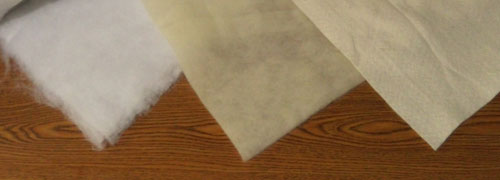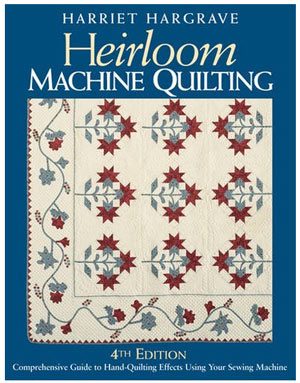- Home
- Machine Quilting 101
- Quilt Batting
Quilt Batting 101
Learn how to choose the best quilt batting for your quilt
This post contains affiliate links for which I receive compensation
Batting (also known as wadding), that cuddly middle layer of a quilt, is made from all kinds of fibers: cotton, wool, silk, bamboo, polyester, corn, alpaca and green plastic bottles...
That's right!
Even recycled pop bottles! Click here to check out Quilter's Dream Green Select Batting.
Each batting has different characteristics.
Learning to choose your batting based on these qualities helps you to create the quilt you have pictured in your mind.
But if you're a beginning quilter
Use a needle punched, 100% cotton batting
for the best beginning machine quilting results.
Needle-punched because it's a stable batting with little stretch. It'll be harder to pull out of shape as you quilt your first quilts.
In the picture below, the sturdier looking batting is on the right, and is needlepunched. It looks and feels very much like a thick felt.
 From left to right, a 100% polyester 'Fatt Bat', 100% wool batting, and 100% cotton batting
From left to right, a 100% polyester 'Fatt Bat', 100% wool batting, and 100% cotton batting100% cotton because cotton likes to stick to the all-cotton fabrics you used to make your quilt top and backing. There'll be virtually no slippage as you quilt. And less slippage means fewer or no tucks.
Compared to other fibers, cotton is both moderately priced and relatively thin which creates less bulk under the arm of your sewing arm. That makes the whole quilt sandwich easier to manipulate.
Quilter's Dream (Select or Request loft) and Warm & Natural are both reputable brands that I confidently recommend to my beginning students. Your local quilt store probably carries one or the other right now, so they're easy to find.
DO NOT let someone sell you batting that isn't labeled. You NEED to know the recommended quilting distance, the fiber content and how to treat and launder the finished quilt.
For your first quilts, this is enough information to start quilting, but once you've quilted a couple of quilts, there's so much more to learn about batting and how it affects the look of your finished quilt.
The Vocabulary of Batting
Quilters use many words to describe the battings they use in their quilts. Understanding them will help you choose the one that gives the effect you want in your final quilt.
Needle-punched
Barbed needles are 'punched' and twisted through the fibers to tangle them into a very stable batting. Needle-punched battings have a felt-like feel and appearance. They can even be used as a 'fabric' for craft projects and some wearable projects.
Thermal bonded
A batting that is heated in order to melt some of the blended fibers. The melted fibers help to hold the batting together. You'll sometimes hear thermal bonding referred to as 'heat-sealed', 'low melt' or 'glazed'.
Thermal bonding helps control or eliminate 'bearding'.
Resin bonded
A chemical bonding agent is either sprayed or painted onto the quilt batting. It is another bonding method that helps control or retard 'bearding'.
Scrim
A polyester, netting-like layer that is applied to the surface of the batting. Many needle-punched battings are needlepunched onto a scrim and produce a very stable (non-stretchy) batting.
Bearding
When batting migrates through the seams and appears on the top or back of a quilt. Bearding tends to make the colors of the quilt look 'hazy'.
Loft
The height or puffiness of a batting.
A low loft batting creates a flat, antique looking quilt (like the Quilter's Dream 100% cotton batting on the right below).
A 'Fatt Batt' (100% polyester, below left), by contrast, is intended for a tied quilt. The finished quilt will look more like a comforter.
And there are a variety of other lofts in between like the 100% wool batting shown in the middle below.

The choice is yours!
Neps
Very tiny lumps of tangled fibers that may be found in either cotton and polyester quilt batting. They are hard to hand quilt through.
Shrinkage
The amount that the fibers shrink up or tangle when washed.
Some quilt battings will shrink a lot, some not so much. The way you wash your quilt, the heat of the water, the amount of agitation can effect your results. It is important to read and follow each manufacturers' instructions.
Quilting Distance
The maximum distance between quilting stitches recommended by the manufacturer.
In reality, I wouldn't quilt any further apart than 3 to 4 inches regardless of the type of batting. A wet quilt is a heavy quilt. If you've got to wash your quilt, there just aren't enough stitches to support the weight as you maneuver the wet quilt to dry it. If you think about the antique quilts that have survived to today, they have lots of quilting in them.
Now that you know the words, how do you use them?
A hand quilter may choose to avoid batting with a scrim or that is needle-punched because it's harder to quilt through. If they're set on using a particular type of batting, a thinner, lower loft may be chosen to compensate for the scrim and/or needle-punching.
If you're an heirloom machine quilter, you may want a resin-bonded batting with a mid to high loft to add definition to the quilting designs, without having to do the double stitching and cutting away of the quilt batting for machine trapunto.
If you want a 100% cotton quilt, you may choose to avoid one with a scrim, because the scrim is a polyester product and your quilt will no longer be 100% cotton.
What about how to...
Choose a quilt batting for a baby quilt
A baby quilt is a great project for a beginning quilter. Its small size means it takes less time and money to make, with the added advantage that it's more likely to be finished.
But we want a quilt that's safe for baby.
And your batting choice plays a big part in that.
Many quilters are under the assumption that polyester batting is naturally flame retardant.
But nothing could be further from the truth. Polyester is a petroleum product.
When flame is applied to polyester it melts and drips, and will even do so at high temperatures without a flame. The melted blobs stick to whatever they touch. This melted blob is hard to remove. And especially hard to remove from the skin.
So for quilts that are intended for babies or individuals who have a hard time moving around, I suggest using either a 100% cotton or 100% wool batting, or seeking out a flame retardant batting. (Quilters Dream and The Warm Company are now making one.)
Does this mean you should never use polyester batting? Or polyester blends?
Certainly not!
Just know who and how the quilt will be used and choose your batting accordingly.
Table of Contents
for Beginning Machine Quilting 101
Introduction
Beginning Quilting 101: Quilting Instructions for the Beginner




